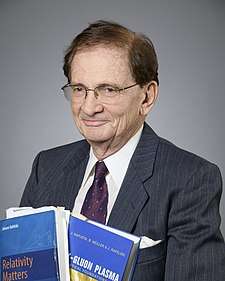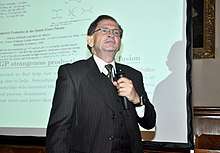Johann Rafelski
Johann Rafelski (born 19 May 1950) is a German-American theoretical physicist. He is professor of Physics at The University of Arizona in Tucson,[1] guest scientist at CERN (Geneva),[2] and has been LMU-Excellent Guest Professor at the Ludwig Maximilian University of Munich in Munich, Germany.
Johann Rafelski | |
|---|---|
 | |
| Born | 19 May 1950 |
| Nationality | US, German |
| Alma mater | Johann Wolfgang Goethe University Frankfurt am Main |
| Known for | Structure of the Vacuum State and Energy in Strong External Field Quantum Electrodynamics and Quantum Chromodynamics, Muon-catalyzed fusion, Hadronization and Hagedorn temperature, Deconfinement of quarks (QGP) in relativistic heavy ion collisions, Strangeness as signature of quark-gluon plasma, quark matter |
| Spouse(s) |
|
| Children | 2 |
| Scientific career | |
| Fields | Physicist |
| Institutions | University of Arizona |
| Doctoral advisor | Walter Greiner |

Rafelski's current research interests center around investigation of the vacuum structure of QCD and QED in the presence of strong fields; study of the QCD vacuum structure and deconfinement with strange particle production[3] in deconfined quark–gluon plasma formed in relativistic heavy ion collisions; the formation of matter out of quark-gluon plasma in the hadronization process,[4] also in the early Universe;[5] considering antimatter formation and annihilation. He has also contributed to the physics of table top muon-catalyzed fusion[6] and the ascent of ultrashort laser light pulses[7] as a new tool in this domain of physics. He contributed to understanding of neural nets and artificial intelligence[8] showing importance of neural plasticity and "sleep".
Career
Rafelski studied physics at Johann Wolfgang Goethe University in Frankfurt, Germany, where he received his PhD in the spring of 1973 working with Walter Greiner on strong fields[9] and muonic atom tests of QED.[10][11] In 1973 he began a series of postdoctoral fellowships: first at the University of Pennsylvania (Philadelphia) with Abraham Klein, then at the Argonne National Laboratory near Chicago where he worked with John W. Clark of Washington University in St. Louis and Michael Danos[12][13] of National Bureau of Standards (now National Institute of Standards and Technology (NIST)).[14] In spring 1977 Rafelski moved for a few months to work at the GSI Helmholtz Centre for Heavy Ion Research in Germany, then continued on to a fellowship at CERN,[15] where he worked with Rolf Hagedorn and John S. Bell; Rafelski remains associated with CERN to this day.[16] In the fall of 1979 Rafelski was appointed tenured associate professor at Johann Wolfgang Goethe University where he taught for 4 years, while collaborating closely with Hagedorn and with Berndt Müller and Gerhard Soff, whom Rafelski mentored in his PhD work. Rafelski then accepted the chair of Theoretical Physics at the University of Cape Town (South Africa)[17] where he created a Theoretical Physics and Astrophysics Institute before moving to The University of Arizona in the fall of 1987. During these years he was also a guest scientist at NIST in Washington, D.C. His interests in muon-catalyzed fusion and other table-top fusion methods led him to a collaboration led by Steven E. Jones[18] working at the Los Alamos National Laboratory.[19] The start-up of experimental work on quark-gluon plasma has led to another enduring collaboration with the University of Paris 7-Jussieu involving Jean Letessier.[20]
Rafelski has been instrumental to the study of quark-gluon plasma (QGP) advancing strangeness production as the pivotal QGP signature,[21][16] for which the first experimental evidence was announced by CERN in February 2000,[22] and now has become a new field of physics.[23][24][16] This work relates to his long-lasting studies to understand the structured quantum vacuum[25] aka Lorentz Invariant Aether.
Honours, decorations, awards and distinctions
- Fellow of the American Physical Society (2011)[26]
Biography
Rafelski was born in Krakow, Poland, on May 19, 1950. In 1973 Rafelski married Helga Betz; their union produced two children. Dr. Helga Rafelski died of cancer in 2000. In 2003 Rafelski married the American novelist Victoria Grossack.
Bibliography
- 2020: Spezielle Relativitätstheorie heute.[27]
- 2017: Relativity Matters: From Einstein's EMC2 to Laser Particle Acceleration and Quark-Gluon Plasma.[28]
- 2016: Melting Hadrons, Boiling Quarks-From Hagedorn Temperature to Ultra-Relativistic Heavy-Ion Collisions at CERN.[29]
- 2002: Hadrons and Quark–Gluon Plasma.[30]
- 1996: Die Struktur des Vakuums. Ein Dialog über das 'Nichts'.[31]
- 1992: Spezielle Relativitätstheorie.[32]
- 1985: Quantum Electrodynamics of Strong Fields.[33]
References
- "Faculty Senate roster". The University of Arizona. Archived from the original on 4 December 2019. Retrieved 10 March 2020.
- "Rafelski's scientific articles published with CERN affiliation". INSPIRE HEP database. 10 March 2020.
- Rafelski, Johann; Müller, Berndt (1986). "Strangeness Production in the Quark-Gluon Plasma". Physical Review Letters. 56 (21): 2334. doi:10.1103/PhysRevLett.56.2334. ISSN 0031-9007.
- Koch, P; Müller, B; Rafelski, J (1986). "Strangeness in relativistic heavy ion collisions". Physics Reports. 142 (4): 167–262. Bibcode:1986PhR...142..167K. doi:10.1016/0370-1573(86)90096-7. ISSN 0370-1573.
- Fromerth, Michael J.; Rafelski, Johann (2003-04-15). "Hadronization of the Quark Universe". arXiv:astro-ph/0211346.
- Rafelski, Johann; Jones, Steven E. (1987). "Cold Nuclear Fusion". Scientific American. 257 (1): 84–89. Bibcode:1987SciAm.257a..84R. doi:10.1038/scientificamerican0787-84. ISSN 0036-8733. JSTOR 24979424.
- Cowen, Ron (2013). "Two-laser boron fusion lights the way to radiation-free energy". Nature. doi:10.1038/nature.2013.13914. ISSN 0028-0836.
- Clark, John W.; Rafelski, Johann; Winston, Jeffrey V. (1985). "Brain without mind: Computer simulation of neural networks with modifiable neuronal interactions". Physics Reports. 123 (4): 215–273. Bibcode:1985PhR...123..215C. doi:10.1016/0370-1573(85)90038-9. ISSN 0370-1573.
- Rafelski, J.; Müller, B.; Greiner, W. (1974). "The charged vacuum in over-critical fields". Nuclear Physics B. 68 (2): 585–604. Bibcode:1974NuPhB..68..585R. doi:10.1016/0550-3213(74)90333-2.
- Rafelski, Johann (1973). Selbstkonsistente Vielteilchengleichungen fur Elektronen und Muonen und ihre Effekte in Muonischen Atomen (PDF) (PhD). Frankfurt: Frankfurt University.
- Rafelski, Johann; Müller, Berndt; Soff, Gerhard; Greiner, Walter (1974). "Critical discussion of the vacuum polarization measurements in muonic atoms". Annals of Physics. 88 (2): 419–453. Bibcode:1974AnPhy..88..419R. doi:10.1016/0003-4916(74)90177-8.
- "Guide to the Michael Danos Papers 1950-2003". www.lib.uchicago.edu. Retrieved 2020-03-17.
Box 22, folder 8: Rafelski, biographical material and letters of recommendation, 1991
- Michael Danos (2001). Proceedings of the Symposium on Fundamental Issues in Elementary Matter: 25-29 September 2000, Bad Honnef, Germany : in honor and memory of Michael Danos. EP Systema. pp. 416–. ISBN 978-963-00-5764-6.
- O'Brien, Margaret (3 Sep 1999). "Theoretical physicist Michael Danos". Chicago Tribune. Retrieved 2020-03-17.
- "The Authors". Scientific American. 241 (6): 19. 1979. Bibcode:1979SciAm.241f..19.. doi:10.1038/scientificamerican1279-19. ISSN 0036-8733.
- Rafelski, Johann (2020). "Discovery of Quark-Gluon Plasma: Strangeness Diaries". The European Physical Journal Special Topics. 229 (1): 1–140. arXiv:1911.00831. Bibcode:2020EPJST.229....1R. doi:10.1140/epjst/e2019-900263-x. ISSN 1951-6355.
- Rafelski, Johann (1984). Why and how in theoretical physics : inaugural lecture (PDF). Cape Town: University of Cape Town. ISBN 9780799205886.
- "The Authors". Scientific American. 257 (1): 14–15. 1987. Bibcode:1987SciAm.257a..14.. doi:10.1038/scientificamerican0787-14. ISSN 0036-8733.
- Jones, S. E.; Palmer, E. P.; Czirr, J. B.; Decker, D. L.; Jensen, G. L.; Thorne, J. M.; Taylor, S. F.; Rafelski, J. (1989). "Observation of cold nuclear fusion in condensed matter". Nature. 338 (6218): 737–740. Bibcode:1989Natur.338..737J. doi:10.1038/338737a0. ISSN 0028-0836.
- Rafelski, Johann; Letessier, Jean (2004). "Strangeness and quark–gluon plasma". Journal of Physics G: Nuclear and Particle Physics. 30 (1): S1–S28. arXiv:hep-ph/0305284. Bibcode:2004JPhG...30S...1R. doi:10.1088/0954-3899/30/1/001. ISSN 0954-3899.
- Quercigh, Emanuele; Rafelski, Johann (2000). "A strange quark plasma". Physics World. 13 (10): 37–42. doi:10.1088/2058-7058/13/10/35. ISSN 0953-8585.
- Abbott, Alison (2000). "CERN claims first experimental creation of quark–gluon plasma". Nature. 403 (6770): 581. Bibcode:2000Natur.403..581A. doi:10.1038/35001196. ISSN 0028-0836. PMID 10688162.
- Torrieri, G. (2012). "My Strange Times with Johann Rafelski". Acta Physica Polonica B. 43 (4): 821. doi:10.5506/APhysPolB.43.821. ISSN 0587-4254.
- "Exploring strangeness and the primordial Universe". ScienceDaily. 31 January 2020. Retrieved 12 March 2020.
- Fulcher, Lewis P.; Rafelski, Johann; Klein, Abraham (1979). "The Decay of the Vacuum". Scientific American. 241 (6): 150–159. Bibcode:1979SciAm.241f.150F. doi:10.1038/scientificamerican1279-150. ISSN 0036-8733. JSTOR 24965361.
- "APS fellow archive". American Physical Society. Retrieved 10 March 2020.
- Rafelski, Johann (2020). Spezielle Relativitätstheorie heute : Schlüssig erklärt mit Beispielen, Aufgaben und Diskussionen. doi:10.1007/978-3-662-59420-9. ISBN 978-3-662-59419-3.
- Rafelski, Johann (2017). Relativity Matters: From Einstein's EMC2 to Laser Particle Acceleration and Quark-Gluon Plasma. Springer. ISBN 978-3-319-51230-3.
- Rafelski, Johann, ed. (2016). Melting Hadrons, Boiling Quarks-From Hagedorn Temperature to Ultra-Relativistic Heavy-Ion Collisions at CERN. Springer International Publishing: Imprint: Springer. ISBN 978-3-319-17545-4.
- Letessier, Jean; Rafelski, Johann (2002). Hadrons and Quark–Gluon Plasma. Cambridge University Press. ISBN 9780521385367.
- Rafelski, Johann; Müller, Berndt (1996). Die Struktur des Vakuums. Ein Dialog über das 'Nichts'. Deutsch Harri GmbH. ISBN 978-3871448881.
- Greiner, Walter; Rafelski, Johann (1992). Spezielle Relativitätstheorie. H. Deutsch Verlag. ISBN 3-8171-1205-X.
- Greiner, Walter; Müller, Berndt; Rafelski, Johann (1985). Quantum Electrodynamics of Strong Fields. Springer-Verlag. ISBN 978-3-642-82272-8.
External links
- Johann Rafelski's website
- Scientific publications of Johann Rafelski on INSPIRE-HEP
- Greco, Virginia (6 February 2018). "Relativity Matters: Interview with Johann Rafelski". Alice Matters. CERN. Retrieved 13 May 2019.